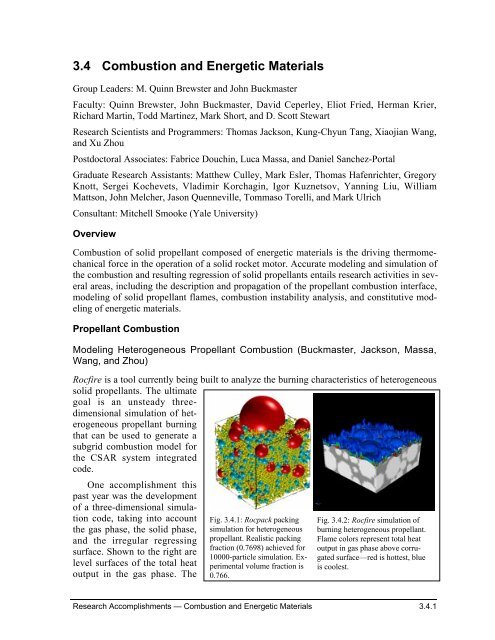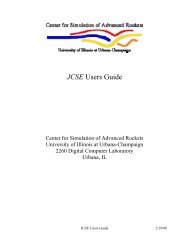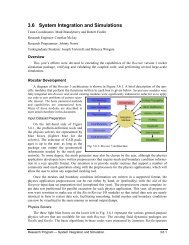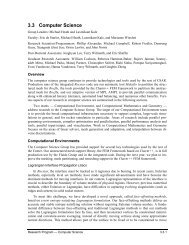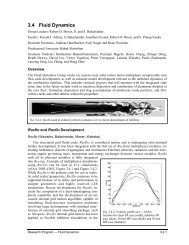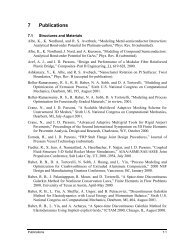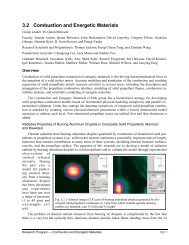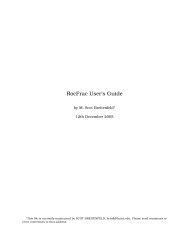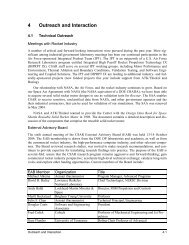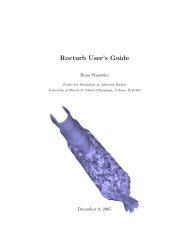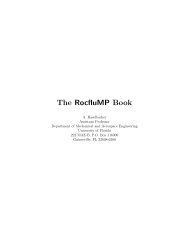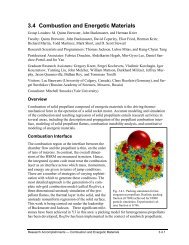3.4 Combustion and Energetic Materials
3.4 Combustion and Energetic Materials
3.4 Combustion and Energetic Materials
Create successful ePaper yourself
Turn your PDF publications into a flip-book with our unique Google optimized e-Paper software.
<strong>3.4</strong> <strong>Combustion</strong> <strong>and</strong> <strong>Energetic</strong> <strong>Materials</strong><br />
Group Leaders: M. Quinn Brewster <strong>and</strong> John Buckmaster<br />
Faculty: Quinn Brewster, John Buckmaster, David Ceperley, Eliot Fried, Herman Krier,<br />
Richard Martin, Todd Martinez, Mark Short, <strong>and</strong> D. Scott Stewart<br />
Research Scientists <strong>and</strong> Programmers: Thomas Jackson, Kung-Chyun Tang, Xiaojian Wang,<br />
<strong>and</strong> Xu Zhou<br />
Postdoctoral Associates: Fabrice Douchin, Luca Massa, <strong>and</strong> Daniel Sanchez-Portal<br />
Graduate Research Assistants: Matthew Culley, Mark Esler, Thomas Hafenrichter, Gregory<br />
Knott, Sergei Kochevets, Vladimir Korchagin, Igor Kuznetsov, Yanning Liu, William<br />
Mattson, John Melcher, Jason Quenneville, Tommaso Torelli, <strong>and</strong> Mark Ulrich<br />
Consultant: Mitchell Smooke (Yale University)<br />
Overview<br />
<strong>Combustion</strong> of solid propellant composed of energetic materials is the driving thermomechanical<br />
force in the operation of a solid rocket motor. Accurate modeling <strong>and</strong> simulation of<br />
the combustion <strong>and</strong> resulting regression of solid propellants entails research activities in several<br />
areas, including the description <strong>and</strong> propagation of the propellant combustion interface,<br />
modeling of solid propellant flames, combustion instability analysis, <strong>and</strong> constitutive modeling<br />
of energetic materials.<br />
Propellant <strong>Combustion</strong><br />
Modeling Heterogeneous Propellant <strong>Combustion</strong> (Buckmaster, Jackson, Massa,<br />
Wang, <strong>and</strong> Zhou)<br />
Rocfire is a tool currently being built to analyze the burning characteristics of heterogeneous<br />
solid propellants. The ultimate<br />
goal is an unsteady threedimensional<br />
simulation of heterogeneous<br />
propellant burning<br />
that can be used to generate a<br />
subgrid combustion model for<br />
the CSAR system integrated<br />
code.<br />
One accomplishment this<br />
past year was the development<br />
of a three-dimensional simulation<br />
code, taking into account<br />
the gas phase, the solid phase,<br />
<strong>and</strong> the irregular regressing<br />
surface. Shown to the right are<br />
level surfaces of the total heat<br />
output in the gas phase. The<br />
Fig. <strong>3.4</strong>.1: Rocpack packing<br />
simulation for heterogeneous<br />
propellant. Realistic packing<br />
fraction (0.7698) achieved for<br />
10000-particle simulation. Experimental<br />
volume fraction is<br />
0.766.<br />
Fig. <strong>3.4</strong>.2: Rocfire simulation of<br />
burning heterogeneous propellant.<br />
Flame colors represent total heat<br />
output in gas phase above corrugated<br />
surfaceÑred is hottest, blue<br />
is coolest.<br />
ðResearch Accomplishments Ñ <strong>Combustion</strong> <strong>and</strong> <strong>Energetic</strong> <strong>Materials</strong> <strong>3.4</strong>.1
propellant morphology was computed using Rocpack, an in-house particle packing code.<br />
Rocketeer, an in-house visualization software package, generated the image.<br />
Rocfire was recently parallelized using Fortran 90 <strong>and</strong> MPI. Figure <strong>3.4</strong>.3 shows the results<br />
of scalability studies for Rocfire conducted on the ASCI Blue Pacific <strong>and</strong> on the CSE<br />
Turing cluster. The results are for a scaled problem (number of grid points increase with increasing<br />
number of processors) <strong>and</strong> for a fixed problem (20 million grid points).<br />
Fig. <strong>3.4</strong>.3: Scalability studies for Rocfire conducted<br />
on ASCI Blue Pacific (circle) <strong>and</strong> on CSE<br />
Turing cluster (square).<br />
Fig. <strong>3.4</strong>.4: Rocfire burn rate simulation results<br />
for Miller pack (top curve). Solid curve is<br />
MillerÕs experimental data.<br />
For validation, burning rate simulations were carried out for Miller pack SD-III-17. Figure<br />
<strong>3.4</strong>.4 depicts the experimental burning rates Miller observed, as well as the simulated results<br />
from Rocfire. Each data point derives from a computer run on ASCI Blue Pacific using<br />
25 processors <strong>and</strong> took about four wall clock hours. Future work will focus on the further<br />
development <strong>and</strong> validation of Rocfire, relevant modeling <strong>and</strong> physics issues, <strong>and</strong> the development<br />
of an efficient algorithm for the implementation of a subgrid model into the CSAR<br />
system framework.<br />
Dynamics of Flames in Rectangular Propellant Cracks (Short, Liu)<br />
Thermal or shock ignition of a propellant can lead to fracture <strong>and</strong> cracking, which increases<br />
the available surface area of burning <strong>and</strong> may result in a dramatic change in the mode of<br />
combustion. We have been working towards an underst<strong>and</strong>ing of how burning takes place in<br />
a propellant crack <strong>and</strong> its implications for the safety <strong>and</strong> reliability of energetic materials.<br />
Using direct numerical simulation of the zero Mach number Navier-Stokes equations, we<br />
have simulated flame behavior in the rectangular propellant crack geometry investigated experimentally<br />
by Berghout, Son <strong>and</strong> Asay carried out at the Los Alamos National Laboratory.<br />
Our calculations reveal that steady burning can exist provided the pressure inside the crack is<br />
sufficiently large for a given crack width or the crack sufficiently large for a given pressure.<br />
The flame is shown to oscillate up <strong>and</strong> down the crack under near-limit conditions, i.e., for a<br />
sufficiently small crack width <strong>and</strong>/or pressure, <strong>and</strong> sufficiently large Lewis numbers. These<br />
observations are entirely consistent with the experimental results <strong>and</strong> reveal oscillations in<br />
cracks can occur independently of the L* instability. Future plans include extension to more<br />
realistic crack geometries, including the effect of combustion driven crack propagation.<br />
ðResearch Accomplishments Ñ <strong>Combustion</strong> <strong>and</strong> <strong>Energetic</strong> <strong>Materials</strong> <strong>3.4</strong>.2
Modeling Thermomechanical Structure of Solid Propellant Flames (Stewart, Kuznetsov)<br />
During the last year we have<br />
been analyzing the thermomechanical<br />
structure of<br />
solid propellant (SP) flames.<br />
This includes the temperature,<br />
velocity, stress <strong>and</strong> reaction<br />
profiles in both the solid <strong>and</strong><br />
the gas, with an aim to carefully<br />
revisit traditional assumptions<br />
<strong>and</strong> models. We<br />
completed <strong>and</strong> published a<br />
simple, but thermodynamically<br />
consistent, model of a<br />
thermal expansion boundary<br />
layer that can occur near the<br />
melt or transition temperature<br />
in solid propellant constituents<br />
such as AP or HTPB.<br />
The results show the formation<br />
of a thin region near the<br />
edge of the solid surface where energy is consumed by thermal expansion work, which leads<br />
to a decrease in temperature <strong>and</strong> sharpening of the temperature gradient. The results also<br />
show a significant displacement or swelling of the material at the interface that may lead to<br />
material degradation <strong>and</strong> microcracking near the solid interface. This year we started work on<br />
extensions to multidimensional, time-dependent SP flame structures that are sensitive to the<br />
structure of the temperature profile.<br />
Nonlinear Dynamic Burning Rate Simulation (Tang)<br />
Fig. <strong>3.4</strong> 5: Temperature profiles in AP computed for constant thermal<br />
expansion (dotted) <strong>and</strong> rapidly varying thermal expansion near the<br />
sublimation temperature (solid). All positions in microns.<br />
The phenomenological Zeldovich-Novozhilov<br />
nonlinear dynamic combustion model<br />
(Rocburn) has been successfully implemented<br />
in the integrated simulation codes (GEN1 <strong>and</strong><br />
GEN 2). The coupled unsteady one-dimensional<br />
surface reaction condensed phase governing<br />
equations <strong>and</strong> quasi-steady empirical gas phase<br />
equations are solved numerically. The empirical<br />
gas phase expression reduces to the usual form<br />
for macroscopically steady burning conditions:<br />
r b = aP n . Nonlinear pressurization-rate dependent<br />
combustion during initial pressurization in<br />
solid propellant rockets is captured. To validate<br />
the dynamic combustion model for composite<br />
propellant, the ÒignitionÓ spike commonly ob-<br />
P (atm)<br />
40<br />
35<br />
30<br />
25<br />
20<br />
15<br />
10<br />
5<br />
ZN Dynamic (Rocburn)<br />
Quasi-Steady (r b<br />
=aP n )<br />
Measured (NAWC Motor 13)<br />
0<br />
0 1 2 3 4<br />
t (sec)<br />
Fig. <strong>3.4</strong>.6: Numerical <strong>and</strong> experimental NAWC<br />
tactical motor 13 pressure-time history (cylindrical<br />
grain, a=0.07696 cm/sec, n=0.461, P in<br />
atm, initial L* = 7.5 m).<br />
ðResearch Accomplishments Ñ <strong>Combustion</strong> <strong>and</strong> <strong>Energetic</strong> <strong>Materials</strong> <strong>3.4</strong>.3
served in motors with small L* (which is traditionally attributed to erosive burning or igniter<br />
mass flux) is simulated for a tactical motor with AP composite propellant, similar to what has<br />
been previously demonstrated for homogeneous propellant. Figure <strong>3.4</strong>.6 shows the calculated<br />
<strong>and</strong> measured pressure-time history for NAWC motor 13 considering only bulk mode chamber<br />
filling <strong>and</strong> empting effect. No erosive burning has been included. There is also no structural<br />
coupling <strong>and</strong> no flowfield effects. The measured head-end pressure is compared with<br />
the numerical calculated pressure. The pressure spike behavior is reproduced well by the<br />
nonlinear dynamic combustion model (Rocburn) calculation without any particular adjustment<br />
of parameters <strong>and</strong> without considering the erosive burning effect. The quasi-static prediction<br />
(no dynamic burning) misses the spike entirely. Similarly, the result generated by the<br />
integrated system code (GEN1) that includes the three-dimensional flowfield effect draws the<br />
same conclusion.<br />
Multi-dimensional Flame Structure <strong>and</strong> Propellant Regression Rate Simulation <strong>and</strong><br />
Validation (Genevieve, Brewster)<br />
The two-dimensional s<strong>and</strong>wich or laminate propellant configuration is being used to develop<br />
<strong>and</strong> validate simplified kinetics models for AP/hydrocarbon composite solid propellant combustion.<br />
The quantities being compared with experimental results to validate the model are<br />
gas-phase flame structure, burning surface profile, <strong>and</strong> regression rate. Our simulations include<br />
the effect of oxygenating the binder with fine-AP. This will allow us to simulate bimodal<br />
AP composite propellants that contain a bimodal size distribution of AP (coarse <strong>and</strong><br />
fine).<br />
Future efforts will be to validate the model based on comparison with experimental results,<br />
with the objective of achieving quantitative predictive capability. Specifically, efforts<br />
will be focussed on flames formed between AP laminae (representing coarse AP particles)<br />
<strong>and</strong> binder oxygenated with fine-AP particles. Another area of focus will be condensed-phase<br />
decomposition kinetics.<br />
Structure of Burning Aluminum<br />
Particles in Solid Rocket Motors<br />
(Krier, Melcher)<br />
The rate that aluminum particles<br />
burn <strong>and</strong> the structure of their oxide<br />
smoke clouds surrounding the<br />
aluminum droplets burning were<br />
studied in a solid rocket motor<br />
(SRM) flow. Chamber conditions<br />
were 6-22 atm <strong>and</strong> 2300 K, filled<br />
by burning a stoichiometric<br />
AP/HTPB propellant, with the<br />
burning aluminum droplets being<br />
generated by co-burning an aluminized<br />
solid propellant. Optical<br />
imaging of the burning droplets<br />
<strong>and</strong> surrounding smoke clouds<br />
D o<br />
/<br />
D<br />
1<br />
0.8<br />
0.6<br />
0.4<br />
0.2<br />
D 0.75 1.0 D1.8<br />
D<br />
single droplets (this study)<br />
agglomerates (this study)<br />
Hermsen Model (R=2.7)<br />
0<br />
0 1 2 3 4 5 6 7<br />
time (msec)<br />
Fig. <strong>3.4</strong>.7: Comparison of predicted mean burn history of 100<br />
µm droplet for agglomerated droplet data, single droplet data,<br />
<strong>and</strong> Hermsen Model. For Hermsen model, rocket motor conditions<br />
at pÊ=Ê15Êatm <strong>and</strong> X eff Ê=Ê56%.<br />
ðResearch Accomplishments Ñ <strong>Combustion</strong> <strong>and</strong> <strong>Energetic</strong> <strong>Materials</strong> <strong>3.4</strong>.4
was conducted using a high-speed video CCD with high-magnification optics. An Abel inversion<br />
was used to de-convolute the imaged droplet intensity profiles to true intensity profiles.<br />
Measurements of the de-convoluted intensity profiles show that the non-dimensional<br />
smoke cloud size surrounding the burning droplets is not constant with diameter, but instead<br />
grows with smaller droplet diameters, by r/rs ~ D-0.5. A quasi one-dimensional model was<br />
also developed to describe the oxide cap accumulation on the droplet surface from the oxide<br />
smoke cloud surrounding the droplet. Modeling results suggest that less oxide accumulates in<br />
high-pressure SRM conditions when considering mass burning rates for different relative cap<br />
sizes. The final result of the correlation analysis, equation (a), is the corrected burning rate<br />
law for single droplets in SRM conditions (13-22 atm) for a 100 mm diameter single droplet:<br />
D».75 = Do».75 - 8 t [mm, msec] (a)<br />
Continuum Mechanics Strategies (Fried)<br />
Research has continued on incorporating aspects of interfacial structure in a thermodynamically<br />
consistent <strong>and</strong> properly invariant model for a combustion layer as a sharp nonmaterial<br />
interface. An asymptotic analysis comparing the results of analogous one-dimensional problems<br />
formulated within a sharp-interface model for <strong>and</strong> a conventional combustion model has<br />
performed. This analysis yields forms for the constitutive equations in the sharp-interface<br />
model in terms of the well-recognized parameters of the conventional model. In addition,<br />
work has been performed on the foundation of the yield condition <strong>and</strong> flow rule in rateindependent<br />
finite-strain plasticity.<br />
Simulation of <strong>Energetic</strong> <strong>Materials</strong><br />
Quantum Dynamics Methods (Martinez, Quenneville)<br />
We are developing first-principles quantum dynamics methods (ab initio multiple spawning<br />
or ÒAIMSÓ) <strong>and</strong> extending these to large molecules <strong>and</strong> condensed phases. In previous years,<br />
they have shown the feasibility of this approach for gas phase reactions of energetic molecules<br />
<strong>and</strong> also demonstrated the accuracy of the methods by direct comparison of simulations<br />
with experimental results for short time dynamics as probed by femtosecond spectroscopy.<br />
This year, we have probed the accuracy of the method for bond rupture processes of organic<br />
molecules important in combustion. We have also improved the treatment of electron correlation<br />
in AIMS, which can be an important factor in the accuracy of simulation results. A<br />
new fluctuating charge model has been proposed that will allow larger molecules to be<br />
treated. An AIMS study of the fluorescence quenching of excited OH radicals is in progress<br />
in order to better calibrate the rate of this reaction that is often used as a probe of OH radical<br />
concentration in combustion processes.<br />
Over the coming year, we will focus on efficient implementation of some of the methods<br />
which have been tested at the conceptual level Ð time-displaced basis sets, quadratic valence<br />
bond fluctuating charge models, tunneling corrections in AIMS, <strong>and</strong> higher-order corrections<br />
for basis set propagation. We will also begin the application of AIMS methods to combustion<br />
reactions involving ammonium perchlorate <strong>and</strong> aluminum particles.<br />
ðResearch Accomplishments Ñ <strong>Combustion</strong> <strong>and</strong> <strong>Energetic</strong> <strong>Materials</strong> <strong>3.4</strong>.5
Path Integral Monte Carlo Simulations of Hot, Dense Hydrogen (Ceperley, Esler,<br />
Douchin)<br />
We have further developed <strong>and</strong> tested better methods for Path Integral Monte Carlo simulations,<br />
<strong>and</strong> applied these new methods to dense hydrogen. We have continued study of the hydrogen<br />
phase-diagram <strong>and</strong> the nature of the transition from molecular hydrogen to metallic<br />
hydrogen. Good agreement has been shown at relatively low densities with semi-empirical<br />
theories <strong>and</strong> submitted for publication comparison of our calculations with double shock experiments.<br />
The results were presented at the international workshop on high-pressure physics<br />
at the Institute for Theoretical physics at UCSB. We have compared the efficiency of various<br />
quantum Monte Carlo methods to obtain the electron correlation energy <strong>and</strong> have demonstrated<br />
that the newly devised ÒCoupled Electronic-Ionic Monte CarloÓ method is efficient<br />
for calculations of warm dense matter such as occurs in combustion. In particular we performed<br />
simulations of molecular hydrogen in the temperature range of 1000K without assuming<br />
an intermolecular potential or a density functional for the electrons. The student supported<br />
by this grant (Esler) worked at LLNL as a visiting student during the summer 2001.<br />
In the coming year we will continue work on hydrogen in conjunction with Berkhard<br />
Militzer at LLNL to produce a comprehensive equation of state <strong>and</strong> develop faster simulation<br />
methods; develop <strong>and</strong> apply a method for using pseudo-potentials in path integral Monte<br />
Carlo to allow simulations of heavier elements such as energetic materials at high temperatures<br />
<strong>and</strong> pressures; <strong>and</strong> further develop <strong>and</strong> apply the Coupled Electronic-Ionic Monte Carlo<br />
simulation technique.<br />
Behavior of Molecular-scale <strong>Materials</strong> at High Temperatures <strong>and</strong> Pressures (Martin,<br />
Sanchez-Portal, Mattson)<br />
During this year our work has come to an exciting point where we are making simulations to<br />
compare with new experiments that have uncovered a dense phase of nitrogen metastable at<br />
high pressure. Such phases have been predicted <strong>and</strong> indicated by shock wave data, but never<br />
before found at low temperature. CSAR investigators<br />
chose this problem because such a phase<br />
could be a model for energetic materials (essentially<br />
all energetic materials are nitrogen compounds);<br />
the recent experiments have given a new<br />
urgency <strong>and</strong> significance our simulations.<br />
Our preliminary work has simulated shock<br />
waves in general agreement with the data of Nellis,<br />
et al., at LLNL, predicting molecular to nonmolecular<br />
transformations at temperatures<br />
T~8000-12,000K. Upon quenching at high pressure<br />
(~200GPa) an amorphous non-molecular connected<br />
network is formed (Figure <strong>3.4</strong>.8), which we<br />
find to be metastable at low temperature (
In the future we will carry out more complete simulations of nitrogen <strong>and</strong> other molecular<br />
materials at high pressures <strong>and</strong> temperatures. The main issues will be to clarify the possible<br />
new structures for nitrogen at low temperature; to study reaction kinetics between different<br />
bonding states in the nitrogen system; <strong>and</strong> to proceed to hydrocarbons <strong>and</strong> systems containing<br />
C, N, H, <strong>and</strong> O. Reaction kinetics is the crucial issue both in the accuracy of the physical<br />
approximations <strong>and</strong> in the need for efficient algorithms to identify crucial, but rare, events in<br />
simulations.<br />
ðResearch Accomplishments Ñ <strong>Combustion</strong> <strong>and</strong> <strong>Energetic</strong> <strong>Materials</strong> <strong>3.4</strong>.7


